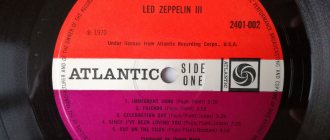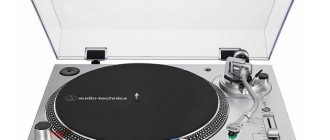Home |
Articles about vinyl Any assessment, including vinyl records, is initially subjective, but the application of generally accepted criteria makes it more or less objective and reliable (corresponding to the true state of the object being assessed).
To assess the condition of vinyl records, an international grading system has long been used, which allows a fairly accurate description of the condition of any record. At the same time, both its sound and appearance, including the appearance of the envelope, are evaluated.
It is worth noting that the sound rating directly depends on the level of quality and correct settings of the equipment used.
Below are the internationally accepted designations for the quality of vinyl records, as well as abbreviations in the comments to the description of vinyl records.
A walk into the past
About 8-10 years ago the era of the vinyl renaissance began
As now, in the “pre-digital” era of sound recording, magnetic tape (film) with the original release was used to stamp records. This is the basis. It was called (and is still called) the master tape. So, from the tape recorder, the sound signal was transferred to a professional specialized device, which had a needle that cut grooves on a soft, waxy disk (it is still called that way, despite the fact that higher-quality, improved analogues have long been used). It resembled a record player in many ways.
Next came complex electroplating procedures involving various chemical and physical manufacturing processes. And all this was necessary in order to create a hard metal cast from a soft disk. And the wax print, as a rule, died heroically, sacrificing itself for the future edition of its brilliant vinyl counterparts.
So, the metal matrix is ready. It turned out to be completely inverse. From this matrix it is quite possible to start printing the circulation of a new album, but the technologists of the past acted differently...
From the resulting inverse matrix, another, most important iron cast was made, and no longer in the least bit inverse. This is how Her Majesty the Mother Matrix was born. On the basis of this main iron plate, a large number of exact copies of this matrix were produced, and they were sent to the workshops of the plant, to other factories and countries. Vinyl discs were made from these exact copies.
What tricks lead to...
The creation and distribution of a large number of copies of the mother matrix is rather an ideal case and an exception to the rules within the production of a circulation, so it happened that in practice it turned out differently: huge containers with copies of the mother matrices were quite difficult to distribute to all the necessary authorities. Because of this, manufacturers often sent a regular copy of the magnetic master tape to foreign factories so that specialists from other vinyl production plants could tinker with it themselves and create a matrix based on it on their own. And it seems that everything was cleverly invented, but the most offensive thing here is that all these “wisdoms” did not have the best effect on the sound quality. After all, a matrix created only from a copy of the master tape can never have the quality of the original.
Mother matrices were not stored forever. If, for example, after a couple of years, the question of reprinting a vinyl edition was raised, then new matrices were created, and the original master tape was not always used as the basis.
This is how the concept of the original first press arose, which is still endlessly valued by connoisseurs and collectors. Therefore, the very first edition produced initially is the most luxurious edition. Pervopress by its very definition sounds much better than most reissues of the record. You can always verify this personally by taking your favorite vinyl of the first pressing and its subsequent reissues. When the player is set up correctly, you will hear a clear difference.
It is curious that somewhere in the early 80s of the last century, a completely innovative DMM technology at that time began to be used (including in the USSR). It assumed the absence of a soft wax cast, and the metal matrix was cut directly into the metal. Eliminating a link without losing quality is always a plus. And the elimination of the wax disc was no exception.
5 good signs of good quality production:
- In terms of playback speed, 45 rpm vinyl records are better than 33 rpm vinyl records;
- the wider the distance between the grooves (tracks), the better;
- about vinyl sizes - thick discs are of better quality;
- piccha discs and colored vinyl wear out faster;
- The USA, Britain, Japan and Eastern Europe were and are still considered the best producers of vinyl discs.
Label Contents
The lower part of the label tells about the performer, author or orchestra, a list of compositions or individual parts, or about musical instruments. On very old records, information about the contents of the record was not as eloquent as we are used to seeing it. The records were marked with a code that hid the type of recording and performance under a set of numbers.
The most mysterious part for the uninitiated music lover is the middle part of the label, on which a number of ciphers can be found. The location of the ciphers may be different, but all of them are certainly present on the label.
Monaural recordings were indicated by a triangle , stereophonic recordings by two crossed circles . On many records, for greater clarity, the word STEREO . Next to the recording type is the playback speed in rpm (33 or 45).
On the right (usually) the numbers 1 and 2 indicate the side number of the record. It happens that all the compositions do not fit on one record, in which case the envelope is sold as a book, and the records are accordingly designated in order 1,2,3,4...
The era of the remake: through thorns...
Vinyl remake has a number of specific differences from old records
The vinyl remake has a number of specific differences from the old records. If you are reading this material, it means that you are interested in vinyl and know that the word remake means all new vinyl that began to be produced about 10 years ago.
The era of the vinyl renaissance began after a rather long period of stagnation in record production. In the 80s of the last century, a widespread closure of vinyl factories began in Japan - one of the world's leading producers of vinyl records. Around the mid-90s, there were almost no such enterprises left either in the United States of America or in Europe. There was a tight silence. The lifeless figure began to conquer the market with zeal...
But literally 10 years ago the factories began to be restored. This came as a surprise to many. A wonderful surprise. And now there is a lot of branded, licensed new vinyl on the market - fresh, beautiful and high-quality remakes.
Interestingly, the vinyl remake has a number of differences from old-school records. Let's start with the advantages
:
- In pre-digital times, a large number of vinyl discs were produced from recycled materials, as factories often had to fit within strict budgets allocated for the production of copies. For example, the Soviet State Order did not suggest otherwise. And now only the best and chemically pure production mass is used (by the way, we talked in detail about the specific composition, raw materials and additives for creating modern vinyl records in the article “Making vinyl records: what are they actually made from?”);
- new records are heavy and massive vinyl, which means they are of higher quality than their lighter counterparts;
- Most modern circulations are completely small, that is, a limited number of copies are cut from one mother matrix.
And now a few words about the shortcomings
new vinyl:
- the main disadvantage, in fact, is only one - the incomprehensible and often dubious origin of the master tape used for production, but other problems arise from it...
It is important to know what exactly is the sound source when cutting new vinyl. It could be an ancient, well-preserved master tape, digitized in accordance with the strict rules and regulations of the modern technological process, or a compact disc.
When creating an edition, they now do digitally restored mastering, which exactly duplicates the remastered CD editions that are relevant in our time, but, naturally, with greater resolution and bit depth. And that's not necessarily a bad thing. After all, now the presence of an original master tape is not always the key to super-quality sound. Why? The fact is that tapes of bygone times, arriving on dusty archival shelves, in addition to being eaten with good appetite by cockroaches, they also dry out and wear out. It happens that the best and perfectly preserved copy is not the first, but, for example, the third or fifth, but superbly “preserved.”
As for professional computer restoration - remastering, then a lot depends on ... the directness of the hands of the restorer himself. There are very few good specialists, so their work is worth its weight in gold.
Source differs from source: older means better?
As we have already found out, using the original master tape is not always a good thing. If the material is already crumbling from old age, then you yourself understand what level of sound it can provide... Therefore, the main thing for a vinyl sound recording source is not the originality of the material, but its integrity and physical condition. For example, on the covers of some new jazz and blues reissues there is the following phrase: “restored from the best surviving sources.” An inscription of this kind may even mean that a cassette was used to create the edition, but with excellent recording quality.
All-Union “Melody”
The first long-playing record, the most familiar to us today, although monophonic, was produced at the Aprelevsky plant in 1951. But stereophony did not take long to arrive, and by 1958 stereophonic records were put into production. They came out after the adoption of the RIAA's general standard for recording records and conformed to it.
The inscription at the top of the label “All-Union Record Company MELODIA” , known today throughout the world, dates back to 1964. This is the year of the founding of the Melodiya company, which united record factories and recording studios. With this association, Melodiya headed the state monopoly on the production, distribution and circulation of sound recordings. We can assume that it was at this moment that labels acquired their familiar appearance today.
As vinyl spread, in addition to the Aprelevsky plant, record production was organized in other cities. The Tashkent (left), Leningrad (right), Tbilisi and Riga factories began producing records.
Example of number decoding
Let's look at an example. The code for the record of the group DDT, the album “I Got This Role” is as follows:
С60 28463 007
- C - stereo recording
- 6 - pop music
- 0 — diameter 300 mm
- 28463 - catalog number
- 007 — code for trading organizations
How to find out the year of a vinyl record
The numbering of entries in the catalog is ascending. Until 1961, the numbering was common, and after that it became different for stereo and monophonic recordings. By the number you can determine the year of release of the record. The following table shows the numbers of records released at the beginning of each year:
On some records, under the list of works, the year in which the recording was made is indicated.
Repertory group
Below is the repertoire group of the record (Gr. 3), which determines the cost of the record without packaging (it usually adds another 25 kopecks), which is indicated next to the group. In this case, 2-25, i.e. 2 rubles 25 kopecks. The division into groups is carried out according to the contents of the record:
- Gr.1 - documentary, socio-political records
- Gr.2 - symphonic music, opera, chamber music, literary and dramatic recordings, music of the peoples of the USSR and foreign countries, recordings for children, etc.
- Gr.3 - recordings of operetta, pop and dance music











